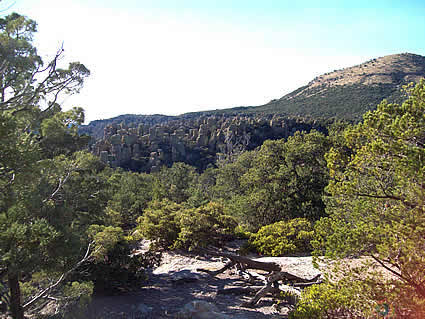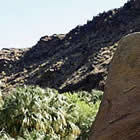Bisbee—queen of the copper camps
The story of a historical treasure trove

Two U.S. Army soldiers were searching for Indian activity in southeastern Arizona Territory in the late 1880s. They spotted some greenish-coloured rocks but no Indians, and so they moved on. A few years later, they returned to the area and filed a claim for what was to become a copper mine. Not any old copper mine, but one that was to exist for 100 years. Here follows the story of the Queen Mine and Bisbee, Arizona, Queen of the Copper Camps.
RVers who live in northern climes tend to spend their winters in places where the sun shines most days. Many head south to Arizona, especially to Tucson, Yuma or Quartzite. Bisbee, although not as well known, is an equally desirable location. We discovered Bisbee while serving as volunteers at a wildlife refuge 30 miles away.
Bisbee came to life with the discovery of copper in 1877. Being in the hills, great difficulty was encountered in finding level land on which to house the thousands who flocked here in search of riches. Brewery Gulch became the place for recreation and relaxation, due to its many saloons and brothels. The town prospered, but lack of suitable sites and water caused mine owners to seek a more favourable location for auxiliary operations. Eventually, a site was found for a smelter, 30 miles away in what was to be called Sulphur Springs Valley. Here Phelps Dodge Corporation established their auxiliary operations close to the Calumet & Arizona Copper Company.
Today, Bisbee is a very different place. Copper is no longer king in Bisbee, but its history lives on: in the Mining Museum; the Queen Mine Tours; the viewing area of the Lavender Pit; and Brewery Gulch. Bisbee is also of interest to wildlife enthusiasts, as described below. But first, let’s see what’s going on today. Seeing the sights in Bisbee is easy because Brewery Gulch and Main Street are right next to each other. The city has a large parking lot at the bottom of both these streets and you only have to walk a short distance to be where all the action is. The Visitor Center is a good place to start for information on current events.
For history buffs, the Mining Museum is housed in the former Phelps Dodge administration building and contains many exhibits relating to copper mining in Bisbee. Once you have familiarized yourself with what copper mining is all about, walk over to the Queen Mine Tour office and purchase a ticket. You will be given a yellow slicker, a hard hat and a large battery-operated lamp prior to climbing aboard a narrow-gauge rail car. The safety gear is important just in case there is a problem underground. Bring a jacket or a sweater, for it is a cool 57 degrees down below, all year long. The tour lasts 90 minutes and is conducted by former mine employees. It is a fabulous experience. After emerging from below ground, walk back to Brewery Gulch and see where all the action was in the late 1880s. It is still pretty lively today—just a different type of activity since the brothels and the saloons are no more! The tables and chairs outside of the Visitor Center, basking in sunlight, are warm and inviting. There are also many restaurants along Main Street and nearby you will see a number of buildings that were once part of the Phelps Dodge complex. The influence that PD had on its “company town” is very evident. The surrounding hillside gives you an idea of how rugged this area really is.
That point was proven when we drove our large pickup truck up a hill on one of the side streets. The roadway became narrower as we ascended, with little room to spare, as we had to back down the tiny space before we could turn around. This proved to be another one of our “white-knuckle drives,” and is not recommended for the faint-hearted. Once back to level ground, take a short ride to the viewing area of the Lavender Pit. Here you can see what an open pit copper mine looks like. Before it closed down, the pit actually surrounded the town!
For those of you who are interested in watching birds, head west out of Bisbee to Ramsey Canyon, where 17 species of hummingbirds can be found, along with the elegant trojan. The adjacent San Pedro Valley is also a magnificent place to view birds. A short distance off of Arizona Highway 80 is the Visitor Center of the Coronado National Memorial. This is where the Spanish explorer, Vasquez de Coronado, entered what is now the United States in 1540. The ride to the top of the mountain in a large truck is another white-knuckle drive, but well worth it, for the views from the top are spectacular, with Mexico and the San Pedro Valley right at your feet. There are plenty of birds here also.
When copper petered out, Bisbee started to decline. Fortunately, new people moved into town and brought new ideas with them. They were resented at first, but eventually the old-timers realized that the new folks were as interested in Bisbee as they were, and Bisbee changed from a company town to a thriving community of artists and retirees. Today, Bisbee is vibrant, with small shops, many restaurants, hotels and plenty to see and do. The RVer will find a number of places to park his or her rig and use as a base for exploring. One RV park we visited was between Bisbee and Douglas. Double Adobe RV Ranch had trees (something not too common in the desert) and good views of Mexico, in addition to a friendly staff.
At the beginning of this piece, we stated that you would be led through a part of southeast Arizona that is very different from Tucson, Yuma or Quartzite. I hope we have convinced you to come and check it out. When you do, you will get to love this area just as we have. Finally, did I hear you ask what a “white-knuckle drive” is? Watch this space and we will explain in a future article.








